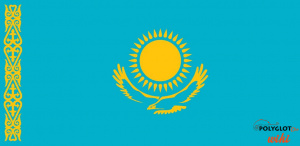Language/Kazakh/Culture/Visual-Arts-and-Crafts
 Հայերէն
Հայերէն Български език
Български език 官话
官话 官話
官話 Hrvatski jezik
Hrvatski jezik Český jazyk
Český jazyk Nederlands
Nederlands English
English Suomen kieli
Suomen kieli Français
Français Deutsch
Deutsch עברית
עברית हिन्दी
हिन्दी Magyar
Magyar Bahasa Indonesia
Bahasa Indonesia فارسی
فارسی Italiano
Italiano 日本語
日本語 한국어
한국어 Lietuvių kalba
Lietuvių kalba Νέα Ελληνικά
Νέα Ελληνικά Şimali Azərbaycanlılar
Şimali Azərbaycanlılar Język polski
Język polski Português
Português Limba Română
Limba Română Русский язык
Русский язык Српски
Српски Español
Español العربية القياسية
العربية القياسية Svenska
Svenska Wikang Tagalog
Wikang Tagalog தமிழ்
தமிழ் ภาษาไทย
ภาษาไทย Türkçe
Türkçe Українська мова
Українська мова Urdu
Urdu Tiếng Việt
Tiếng ViệtKazakh visual arts are rich and diverse, with a long history of traditional techniques and styles. From embroidery to weaving, pottery, and jewelry-making, Kazakh artisans have been creating beautiful and functional objects for generations.
Traditional Embroidery
Embroidery has a long history in Kazakh culture, with each region having its unique styles and patterns. Often, embroidery is done on felt or silk fabrics and is used to decorate clothing, household items, and horse equipment. Some of the most popular embroidery techniques include "zhobanu" and "askar kazak." Zhobanu embroidery features intricate stitching with silk threads, and the end result is a shiny, reflective texture. Askar kazak embroidery is done using a chain stitch and is known for its vibrant colors and geometric patterns.
| Kazakh | Pronunciation | English |
|---|---|---|
| Жобыну | zhobanu | Zhobanu embroidery |
| Асқар қазақ | askar kazak | Askar kazak embroidery |
Weaving
Weaving plays a significant role in Kazakh handicrafts, and it is widely used in making clothing, carpets, and tapestries. The Kazakh loom is known for its simplicity and functionality, allowing weavers to create intricate designs and patterns on fabrics. Some of the most famous Kazakh fabrics are shirdaks (decorative felt carpets), shyrdaks (wool carpets), alakiis (wool rugs), and tushkiizes (pillows). Each region of Kazakhstan has its traditional patterns and designs, with some motifs even featuring in the national emblem of the country.
| Kazakh | Pronunciation | English |
|---|---|---|
| Шырдак | shyrdak | Felt carpet |
| Алакий | alakii | Wool rug |
| Тұшкіізе | tushkiize | Pillow |
Pottery
Pottery has been a part of Kazakh culture for centuries, with many Kazakh families making their own pottery for household use. Today, Kazakh pottery makers create beautiful ceramics using traditional techniques such as hand-building, wheel-throwing, and slip-casting. Popular pottery items include bowls, vases, plates, and teapots. Kazakh pottery is known for its distinctive style and decorative motifs, which often feature the natural world and geometric shapes.
| Kazakh | Pronunciation | English |
|---|---|---|
| Керамикасы | keramikasy | Pottery |
| Күтелес | kuteles | Bowl |
| Ашықтар | ashyqtar | Plate |
Jewelry-making
Kazakh jewelry has its roots in ancient nomadic traditions and is often made using precious metals such as gold and silver. Traditional Kazakh jewelry pieces include belts, necklaces, earrings, bracelets, and rings, and they often feature intricate designs and patterns. Jewelers also use precious stones such as rubies, emeralds, and pearls to add color and texture to their creations.
| Kazakh | Pronunciation | English |
|---|---|---|
| Зергер | zergier | Jeweler |
| Тегереншік | tegerenshik | Earring |
| Құмалақ | kumalak | Necklace |
As you can see, Kazakh visual arts are diverse and rich, reflecting the country's cultural heritage and natural beauty. To learn more about Kazakh culture and its traditions, keep exploring our Complete 0 to A1 Kazakh Course!
Sources
- CULTURE AND THE ARTS IN KAZAKHSTAN | Facts and Details
- Kazakh art - Wikipedia
- Arts & Crafts in Kazakhstan
Related Lessons
- Traditional Games and Pastimes
- Wedding Celebrations
- Singers
- Popular Sports in Kazakhstan
- Festivals and Holidays
- Kazakhstan Timeline
- Cuisine and Culinary Art
- Folk Tales and Legends
- Music and Dance

